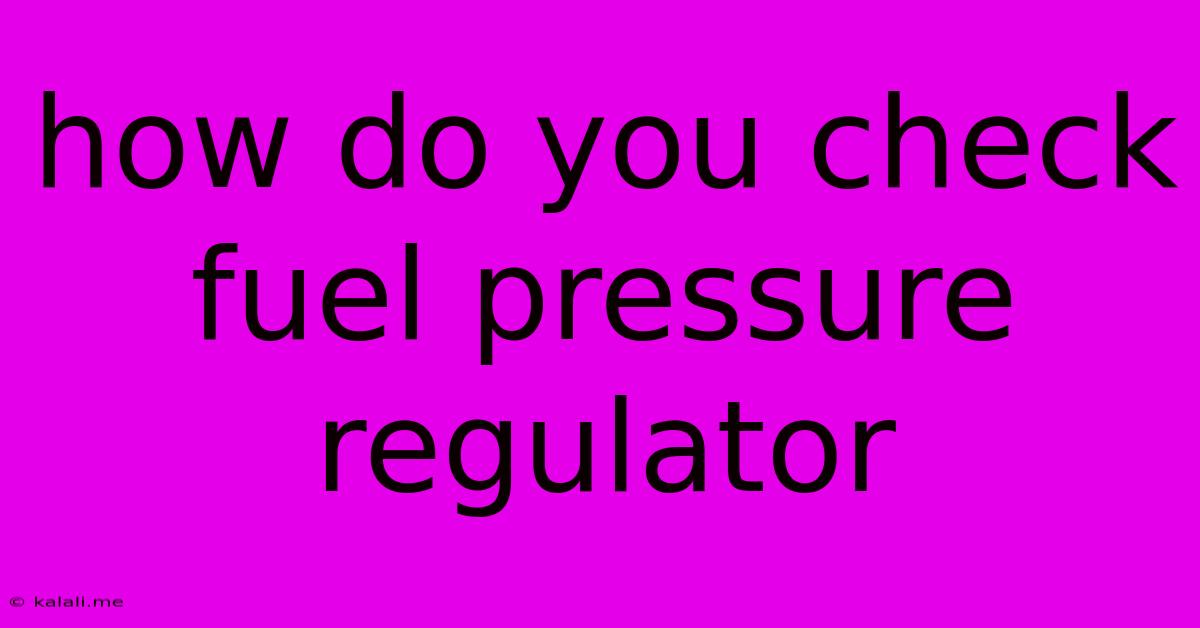How Do You Check Fuel Pressure Regulator
Kalali
Jun 04, 2025 · 3 min read

Table of Contents
How to Check Your Fuel Pressure Regulator: A Comprehensive Guide
A malfunctioning fuel pressure regulator (FPR) can lead to a variety of frustrating car problems, from poor fuel economy and rough idling to a complete engine failure. Understanding how to check your fuel pressure regulator is crucial for maintaining your vehicle's performance and preventing costly repairs. This guide provides a step-by-step process, highlighting safety precautions and important considerations. This will help you diagnose potential issues and determine if your FPR needs replacing.
Understanding the Fuel Pressure Regulator (FPR): Its Role and Importance
The FPR is a vital component in your vehicle's fuel delivery system. Its primary function is to maintain the correct fuel pressure within the fuel rail. This pressure needs to be consistent for optimal engine operation. If the FPR fails, it can either allow too much fuel into the system (resulting in a rich fuel mixture and potential flooding), or it can restrict fuel flow (leading to a lean mixture and engine misfires).
Symptoms of a Faulty Fuel Pressure Regulator:
Before diving into testing, it's essential to identify potential symptoms. A faulty FPR often manifests as:
- Rough idling or stalling: Inconsistent fuel pressure makes for an uneven engine burn.
- Poor fuel economy: Excessive fuel consumption is a common sign of a malfunctioning FPR.
- Engine hesitation or sputtering: The engine may struggle to accelerate or experience sudden power loss.
- Black smoke from the exhaust: A rich fuel mixture, caused by excess fuel, can produce black exhaust smoke.
- Fuel odor: Leaking fuel from a faulty FPR can result in a strong fuel smell around the engine.
- Trouble starting the engine: Insufficient fuel pressure can prevent the engine from starting properly.
Methods for Checking Fuel Pressure Regulator:
There are several approaches to check your fuel pressure regulator, varying in complexity and the tools required.
1. Visual Inspection:
This is the simplest method, requiring no special tools. Carefully inspect the FPR for any obvious signs of damage, such as cracks, leaks, or corrosion. Look for fuel around the regulator or its vacuum line.
2. Fuel Pressure Gauge Test:
This is a more accurate method and requires a fuel pressure gauge. The process varies slightly depending on your vehicle's make and model. Consult your vehicle's repair manual for specific instructions.
- Safety First: Always disconnect the negative battery terminal before starting any work on the fuel system. Fuel is highly flammable, so take necessary precautions.
- Connecting the Gauge: The gauge typically connects to the fuel rail's test port (a Schrader valve similar to a tire valve).
- Measuring Pressure: Start the engine and observe the fuel pressure reading. Compare this reading to the manufacturer's specifications found in your owner's manual. Consistent pressure variations could indicate a faulty FPR. You may also need to test vacuum line disconnection for pressure check. This step can be dangerous, exercise extreme caution and avoid doing this if unfamiliar with the process.
- Testing for Vacuum Leaks: Check the vacuum line connected to the FPR for leaks. A leak can cause incorrect fuel pressure regulation.
3. Vacuum Line Test:
This involves temporarily disconnecting the vacuum line connected to the FPR and plugging it. If the pressure rises significantly, it could point towards a faulty FPR allowing excessive fuel flow. Always have the appropriate tools and experience to execute this test.
Important Notes:
- Consult your vehicle's repair manual: This is essential for detailed instructions and specifications specific to your car model.
- Safety first: Working with fuel systems involves inherent risks. Always prioritize safety and follow appropriate safety procedures.
- Professional Assistance: If you're uncomfortable performing these checks yourself, consult a qualified mechanic. Improperly diagnosing or repairing a fuel system component can cause serious damage.
By following these steps and understanding the potential symptoms, you can effectively check your fuel pressure regulator and determine if it requires replacement. Remember to always prioritize safety and consult your vehicle's repair manual for specific instructions. Early detection and repair can save you significant costs and headaches in the long run.
Latest Posts
Latest Posts
-
Chat Gpt For Grammer Vs Grammerly
Jun 06, 2025
-
How To Plug Guitar Into Computer
Jun 06, 2025
-
Does Beacon Count As A Light Source
Jun 06, 2025
-
Why Is My Download Button Not Working On Mac
Jun 06, 2025
-
3 Wire Stove Plug Wiring Diagram
Jun 06, 2025
Related Post
Thank you for visiting our website which covers about How Do You Check Fuel Pressure Regulator . We hope the information provided has been useful to you. Feel free to contact us if you have any questions or need further assistance. See you next time and don't miss to bookmark.